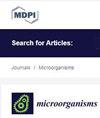Identification of Bioactive Substances Derived from the Probiotic-Induced Bioconversion of Lagerstroemia speciosa Pers. Leaf Extract That Have Beneficial Effects on Diabetes and Obesity
IF 4.1
2区 生物学
Q2 MICROBIOLOGY
引用次数: 0
Abstract
Lagerstroemia speciosa L. (Banaba) has been used as a functional food because of its diuretic, decongestant, antipyretic, anti-hyperglycemic, and anti-adipogenic activities. Triterpene acids, including corosolic acid, oleanolic acid, and asiatic acid, are the principal phytochemicals in Banaba and are potentially anti-diabetic substances, owing to their effect on blood glucose concentration. Bioconversion of Banaba leaf extract (BLE) by Lactobacillus plantarum CBT-LP3 improved the glucose uptake, insulin secretion, and fat browning of this functional food. Furthermore, we identified asiatic acid, which was found to be increased by 3.8-fold during the L. plantarum CBT-LP3-mediated bioconversion process using metabolite profiling. Most previous studies have focused on corosolic acid, another triterpene acid that is a known anti-diabetic compound and is used to standardize BLE preparations. However, asiatic acid is the second most common of the triterpene acids and is also well known to have anti-diabetic properties. The present study has provided strong evidence that asiatic acid represents an alternative to corosolic acid as the most important active compound. These results suggest that the probiotic-mediated bioconversion of BLE may improve the anti-diabetic effects of this functional food. This implies that the consumption of a probiotic should be encouraged for people undergoing BLE treatment to improve its anti-diabetic effects.从益生菌诱导的 Lagerstroemia speciosa Pers.叶提取物中提取的对糖尿病和肥胖症有益的生物活性物质
Lagerstroemia speciosa L.(Banaba)具有利尿、减充血、解热、抗高血糖和抗脂肪生成的活性,因此被用作功能性食品。三萜酸(包括科罗索酸、齐墩果酸和积雪草酸)是 Banaba 的主要植物化学物质,由于其对血糖浓度的影响,可能是抗糖尿病物质。植物乳杆菌 CBT-LP3 对 Banaba 叶提取物(BLE)的生物转化改善了这种功能性食品的葡萄糖吸收、胰岛素分泌和脂肪棕色化。此外,我们还利用代谢物图谱分析发现,在植物乳杆菌 CBT-LP3 介导的生物转化过程中,茜草酸增加了 3.8 倍。之前的大多数研究都集中在科罗索酸上,科罗索酸是另一种三萜类酸,是一种已知的抗糖尿病化合物,被用于标准化 BLE 制剂。然而,茜草酸是第二种最常见的三萜酸,也具有众所周知的抗糖尿病特性。本研究提供了有力的证据,证明积雪草酸可替代科罗索酸,成为最重要的活性化合物。这些结果表明,益生菌介导的 BLE 生物转化可提高这种功能性食品的抗糖尿病效果。这意味着应鼓励正在接受 BLE 治疗的人食用益生菌,以提高其抗糖尿病效果。
本文章由计算机程序翻译,如有差异,请以英文原文为准。
求助全文
约1分钟内获得全文
求助全文
来源期刊

Microorganisms
Medicine-Microbiology (medical)
CiteScore
7.40
自引率
6.70%
发文量
2168
审稿时长
20.03 days
期刊介绍:
Microorganisms (ISSN 2076-2607) is an international, peer-reviewed open access journal which provides an advanced forum for studies related to prokaryotic and eukaryotic microorganisms, viruses and prions. It publishes reviews, research papers and communications. Our aim is to encourage scientists to publish their experimental and theoretical results in as much detail as possible. There is no restriction on the length of the papers. The full experimental details must be provided so that the results can be reproduced. Electronic files and software regarding the full details of the calculation or experimental procedure, if unable to be published in a normal way, can be deposited as supplementary electronic material.
 求助内容:
求助内容: 应助结果提醒方式:
应助结果提醒方式:


